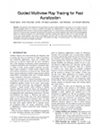Guided Multiview Ray Tracing for Fast Auralization
Appendix A - Animation sequence in Music Hall
IEEE Transactions on Visualization and Computer Graphics (To appear)

We present a novel method for tuning geometric acoustic simulations based on ray tracing. Our formulation computes sound propagation paths from source to receiver and exploits the independence of visibility tests and validation tests to dynamically guide the simulation to high accuracy and performance. Our method makes no assumptions of scene layout and can account for moving sources, receivers, and geometry. We combine our guidance algorithm with a fast GPU sound propagation system for interactive simulation. Our implementation efficiently computes early specular paths and first order diffraction with a multi-view tracing algorithm. We couple our propagation simulation with an audio output system supporting a high order interpolation scheme that accounts for attenuation, cross-fading, and delay. The resulting system can render acoustic spaces composed of thousands of triangles interactively.
 download 157mb
download 157mb
This demo shows interactive sound propagation in two indoor scenes and one outdoor scene.
Thanks to Gamebryo for providing an academic license for their development kit, Marko Dabrovic for his excellent models, and Nicolas Tsingos for his comments on early versions of this work. This work was sponsered by the ARO and the NSF.


